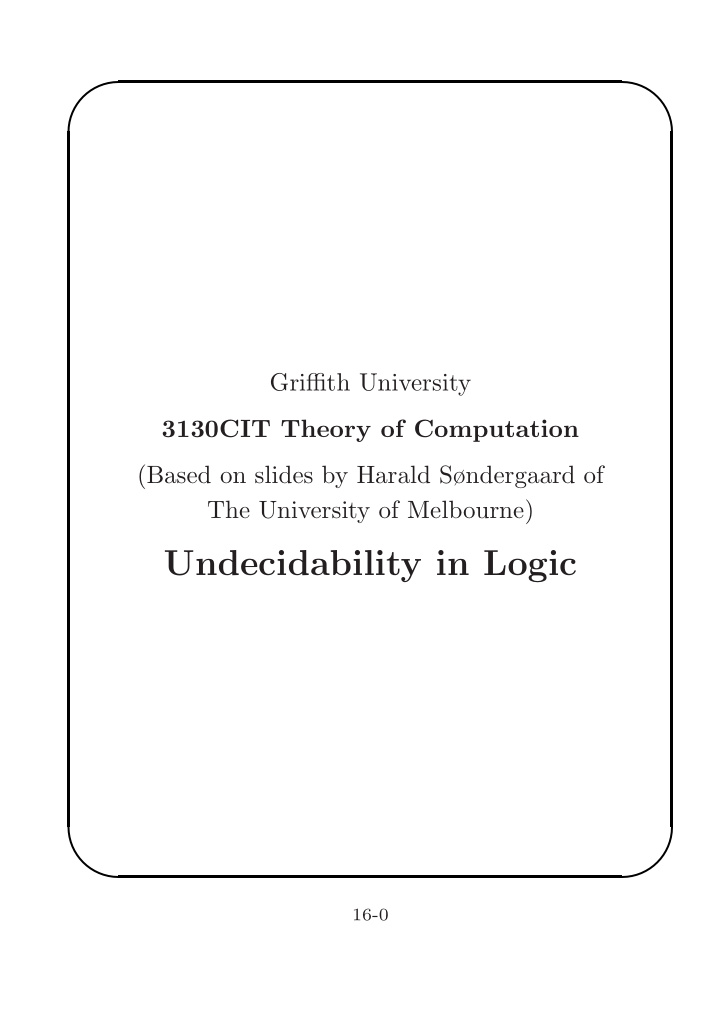



✬ ✩ Griffith University 3130CIT Theory of Computation (Based on slides by Harald Søndergaard of The University of Melbourne) Undecidability in Logic ✫ ✪ 16-0
✬ ✩ Logic Logic is intended to help us study arguments such as Borogoves are mimsy when it is brillig. It is now brillig and this thing is a borogove. Hence this thing is mimsy. Actually, it is intended to help us study axiomatic mathematics (what is a proof, what does it mean to “follow logically”, etc.) Propositional logic can capture some crude properties of deductions. First-order predicate logic is better suited to studying deductions in mathematics. ✫ ✪ 16-1
✬ ✩ Propositional Logic The interesting semantic properties of propositional logic formulas are decidable. For example, if we’re asked whether x ∧ ( y → x ) is a tautology, we can construct the (finite) truth table and answer ‘no’. The truth table can also tell us whether the formula is satisfiable. Moreover, we can write down a set of axioms and inference rules for propositional logic, from which all tautologies can be derived mechanically (and only tautologies are produced). That is, the axiom system is complete . We say that φ is provable, ⊢ φ if it can be derived mechanically. φ is valid (a tautology), | = φ if all truth assignments mapping φ ’s variables to { false , true } ✫ make φ true . ✪ 16-2
✬ ✩ Predicate Logic Predicate logic allows us to express sophisticated properties, about many objects (even infinitely many) in one go. ∀ q ∃ p ∀ x, y [ p > q ∧ ( x, y > 1 → xy � = p )] says that there are infinitely many primes. ∀ a, b, c, n [( a, b, c > 0 ∧ n > 2) → a n + b n � = c n ] says that all quadruples of natural numbers have a certain property (Fermat’s Last Theorem). The quantifiers allow us to make sweeping statements. The interesting semantic problems such as validity or satisfiability of a predicate logic formula turn out to be undecidable. ✫ ✪ 16-3
✬ ✩ Monadic Logic We cross the boundary to the undecidable only when the quantifiers appear together with predicates of arity greater than 1. The fragment of predicate logic which does not allow predicates of arity 2 and above is decidable. ✫ ✪ 16-4
✬ ✩ Predicate Logic (cont.) Predicate logic has a complete axiomatisation. This is G¨ odel’s Completeness Theorem (1930): If | = φ then ⊢ φ . This means that predicate logic allows a proof procedure for validity. Given a valid formula φ , it is possible to verify φ ’s validity in finite time. This is not a decision procedure. (Why not? Can’t we just run the proof procedure on φ and ¬ φ simultaneously?) The point is that there is no proof procedure for satisfiability . ✫ ✪ 16-5
✬ ✩ Elementary Number Theory In predicate logic, relational symbols are uninterpreted, and we leave the universe of discourse unspecified. The semantics of a predicate logic formula φ is in given in terms of all possible interpretations, including universes. We can try to capture specific theories, such as number theory or the theory of commutative groups, by providing suitable axioms and inference rules. For example, for number theory, x + 0 = x x + s ( y ) = s ( x + y ) . . . and the semantics is now given in terms of N and ✫ ✪ the usual meaning of +, s , and so on. 16-6
✬ ✩ G¨ odel’s Incompleteness Theorem G¨ odel’s Incompleteness Theorem (1931) shows that a complete proof procedure is not possible for elementary number theory ( N , + , · ). G¨ odel showed that, for any given proof procedure P , there is a number theoretic statement S P which is true iff it is not provable by P . ✫ ✪ 16-7
✬ ✩ G¨ odel’s Theorem (cont.) In outline, G¨ odel shows that all statements can be encoded as numbers (G¨ odel numbers). It is possible to use the notation of number theory to form a statement p ( x ) which is true iff x is the G¨ odel number of a statement provable by P . So ¬ p ( n ) says that n is not the G¨ odel number of a provable statement. G¨ odel then shows that n can be chosen so that it is in fact the G¨ odel number of the statement ¬ p ( n ) . ✫ ✪ That n is the desired S P . 16-8
✬ ✩ G¨ odel’s Theorem (cont.) This theorem came as a shock in 1931. One might have expected that number theory is not decidable, but G¨ odel showed it was worse. (In a way it isn’t: If we did have completeness, decidability would follow, unlike the case of predicate logic.) ✫ ✪ 16-9
✬ ✩ Other Theories Sipser shows that ( N , +) is decidable. Decidable Complete Propositional logic yes yes Monadic logic yes yes Predicate logic no yes ( N , +) yes yes ( N , + , · ) no no ( R , + , · ) yes yes Ring theory and group theory are undecidable. But fragments or extensions can be decidable. For example, the theory of commutative groups is decidable. ✫ ✪ 16-10
Recommend
More recommend